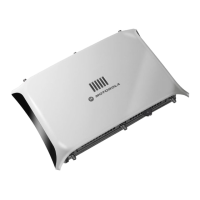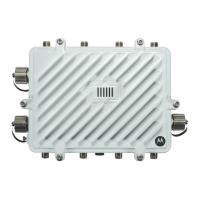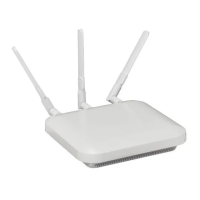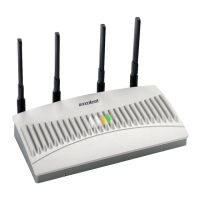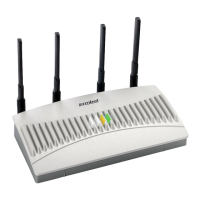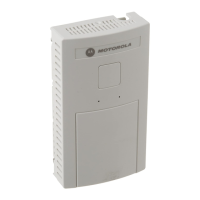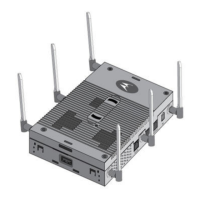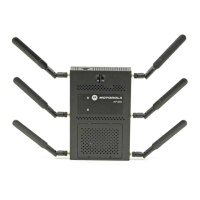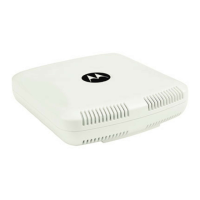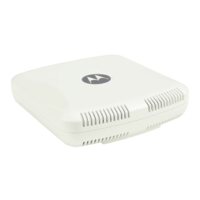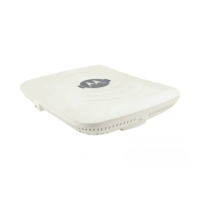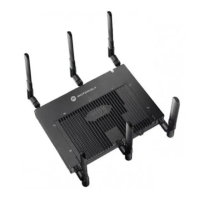
Do you have a question about the Motorola AP-7131 and is the answer not in the manual?
| Brand | Motorola |
|---|---|
| Model | AP-7131 |
| Category | Wireless Access Point |
| Language | English |
Feature enables selection of two power operating modes: legacy IEEE802.3af or Automatic.
Describes the configuration options for single or dual radio models.
Details the access point's LAN and WAN ports and their configurations.
Overview of encryption and authentication techniques for data security.
Explanation of the Kerberos authentication service protocol.
Details the Extensible Authentication Protocol (EAP) feature for enhanced security.
Explanation of Wired Equivalent Privacy (WEP) encryption protocol.
Description of KeyGuard encryption to shield master encryption keys.
Details the Wi-Fi Protected Access (WPA) security standard using TKIP.
Explanation of WPA2-CCMP encryption for stronger wireless security.
Firewall prevents suspicious Internet traffic and performs Network Address Translation (NAT).
Description of Virtual Private Networks (VPNs) for secure remote access.
Allows system administrators to block specific commands and URL extensions.
Electronic separation of data into separate broadcast domains using VLANs.
Functionality to allow the access point to act as a bridge or repeater.
Functionality to provide user database information and authentication.
Allows hotspot operators to provide user authentication and accounting.
An AP-7131 access point that can adopt like an AP300 (L3).
Guidelines for optimal access point performance and placement.
Lists the available power options for the AP-7131.
Describes the AP-7131 Power Injector system for merging power and Ethernet.
Information on planning, installing, and validating the power injector installation.
Details mounting options for the AP-7131.
Make cable and power connections before mounting the access point.
Details connection techniques for configuring the access point.
Procedures for initial connection to the access point.
Using the Java-based Web UI to configure the access point.
Configuring minimum required device settings within the Quick Setup screen.
Steps to configure a basic security policy for a WLAN.
Verifying the access point's link with an MU using WNMP ping packets.
Specifies name, location, email, and restores default configuration.
Enables selection of power operating modes: legacy IEEE802.3af or Automatic.
Defines mechanisms for adopting a switch and routing AAP configuration.
Allows/denies management access from different subnets using various protocols.
Manages security credentials and public keys for message encryption.
Creates certificate requests for VPN access, sends to CA, and imports signed certificate.
Generates certificates to authenticate MUs using the access point's on-board Radius Server.
Facilitates exchange of management information using SNMP.
Specifies which users can read SNMP information and modify related settings.
Manages time and network clock synchronization using NTP.
Sets logging level and views/saves system log.
Obtains configuration settings from another access point or downloads to another access point.
Provides instructions for updating device firmware.
Enables LAN interfaces, assigns names, defines active LAN, and sets timeout.
Electronically separates data into separate broadcast domains.
Configures DHCP settings for LAN1 and LAN2 interfaces.
Sets WAN IP configuration and Point-to-Point Protocol over Ethernet (PPPoE) parameters.
Converts IP addresses between networks and minimizes WAN IP addresses.
Configures port forwarding parameters for inbound traffic from associated WAN IP address.
Creates new WLANs, edits properties of existing WLANs, or deletes WLANs.
Defines or modifies WLAN properties such as ESSID, Name, and Radio.
Sets data protection requirements for the WLAN.
Grants or restricts MU access by specifying MU MAC addresses.
Defines QoS policies for advanced network traffic management.
Enables hotspot operators to provide user authentication and accounting.
Configures 802.11a/n or 802.11b/g/n radio settings for each WLAN.
Grants individual WLANs network bandwidth priority levels.
Manages traffic forwarding using routing tables and protocols.
Configures data protection options including passwords, authentication, and encryption.
Establishes an administrative password for secure access.
Resets the access point password to the factory default via CLI.
Supports authentication (802.1x EAP, Kerberos) and encryption schemes.
Provides strong authentication for client/server applications using secret-key cryptography.
Ties 802.1x EAP authentication protocol to wired and wireless LAN applications.
Provides Wired Equivalent Privacy (WEP) security protocol in two encryption modes.
Motorola's proprietary encryption method, an enhancement to WEP.
Details WPA and WPA2 encryption schemes using TKIP.
Enables or disables configurable firewall filters.
Allows creation of VPN tunnels for secure traffic routing.
Detects unauthorized access points operating within the access point's radio coverage area.
Works with external Radius and LDAP Servers for user authentication.
Views real-time statistics for monitoring access point activity through its WAN port.
Monitors activity of the access point’s LAN1 or LAN2 connection.
Procedures for accessing the Command Line Interface (CLI).
Displays the VPN submenu.
Displays the access point wireless security submenu.
Displays the access point firewall submenu.
Explains AP-7131 mesh networking functionality in client bridge and base bridge modes.
Entails setting LAN configuration, WLAN, and Access Point Radio for mesh support.
Explains AP-7131 adopting like an AP300 (L3) and managed by a wireless switch.
Describes adopting, configuring, and managing AAPs from a wireless switch.
Ensures connection between AAP and switch for configuration.
Configures the switch for AAP adoption.
Provides details for configuring DHCP or BootP Server for firmware/configuration updates.
Provides common questions and answers regarding VPN tunnel configuration.
